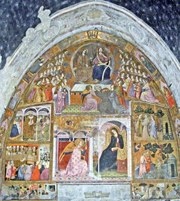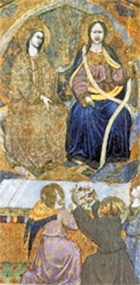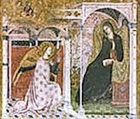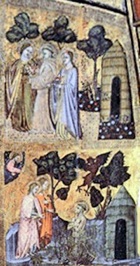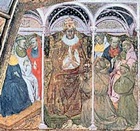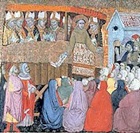This large wooden panel survives in situ on the altar wall of the Portiuncula. The Latin inscription of the frame records that Brother Francesco da Sangemini commissioned it in 1393, a time of war and famine, from the priest Ilario da Viterbo. This is the only known work by this artist and it contains the earliest surviving narrative cycle depicting the granting of the Portiuncula Indulgence.
The upper part of the altarpiece represents miraculous events that happened before this altar. The viewer kneels where
St Francis knelt to receive the Portiuncula Indulgence, holding the roses that had miraculously bloomed in the snow (see below). In the image above, the Virgin conveys to Christ St Francis' request for the Portiuncula Indulgence, thus completing the promise of salvation for all those who, confessing their sins, attend Mass here on the feast day.
The scene immediately below is the Annunciation, the moment at which the history of salvation began with the conception of Christ.
The scenes to the right show the events leading to the apparition:
-
✴St Francis does penance in the brambles, and roses bloom where his blood falls on the snow (in the lower scene); and
-
✴he goes with the angels to the Portiuncula, holding the miraculous roses.
The scenes to the left show the events that followed:
-
✴St Francis receives papal approbation for the Indulgence; and
-
✴he proclaims the Indulgence in the presence of seven bishops outside the
Portiuncula.
Because of the iconic status of the altarpiece, it was visible in its entirety only during the Festa del Perdono and on other important occasions. At other times, it was covered by a silver screen that exposed only small parts of the composition. This screen was stolen by French soldiers in 1798.


